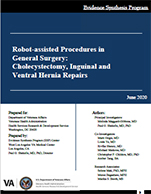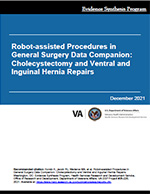
|
Prepared by: Recommended citation: |
Download PDF: Complete Report, Executive Summary, Report, Appendices

This report, through analysis of VHA administrative and registry data, augments the findings from the 2020 ESP systematic review of the published literature on robot-assisted procedures in general surgery compared to other surgical approaches.
General surgery procedures make up a large volume of operations performed in the US. For example there are approximately 1 million cholecystectomies and 800,000 ventral and inguinal hernia cases performed each year. Within this field we are experiencing dramatic recent growth in the number of robot-assisted cases. Questions about the utility of robot-assisted surgery as compared to laparoscopic and open surgery persist. In particular, does the use of the robot translate to better or similar clinical outcomes for patients? Are operating room times and length of stay comparable or improved with use of robot versus laparoscopic or open techniques? And what are costs of robot-assisted surgery and are they justified? Yet there is no consensus or guidelines on when to use which surgical approach and decisions are left up to individual practitioners or hospital leadership. To help clinicians, patients, and policymakers better assess the appropriateness of robot-assisted compared to other surgical approaches, we were asked to conduct a systematic review of the literature on 3 of the most common general surgery operations: cholecystectomy, inguinal hernia repair, and incisional hernia repair.
KQ1A: What is the clinical effectiveness of robot-assisted surgery compared to conventional laparoscopic surgery for cholecystectomy?
KQ2A: What is the cost-effectiveness of robot-assisted surgery compared to conventional laparoscopic surgery for cholecystectomy?
KQ1B: What is the clinical effectiveness of robot-assisted surgery compared to conventional laparoscopic or open surgery for inguinal hernia repair?
KQ2B: What is the cost-effectiveness of robot-assisted surgery compared to conventional laparoscopic or open surgery for inguinal hernia repair?
KQ1C: What is the clinical effectiveness of robot-assisted surgery compared to conventional laparoscopic or open surgery for ventral hernia surgery?
KQ2C: What is the cost-effectiveness of robot-assisted surgery compared to conventional laparoscopic or open surgery for ventral hernia surgery?
Robot-assisted Procedures in General Surgery: Cholecystectomy, Inguinal and Ventral Hernia Repairs (Management eBrief)
Shenoy R, Mederos M, Ye L, et al. Intraoperative and Postoperative Outcomes of Robot-assisted Cholecystectomy: A Systematic Review. Systematic Reviews. Published online April 23, 2021. doi: https://doi.org/10.1186/s13643-021-01673-x.
Ye L, Tang AB, Shenoy R, et al. Clinical and Cost Outcomes of Robot-Assisted Inguinal Hernia Repair: A Systematic Review. Journal of the American College of Surgeons. 2021;232(5):746-763.e2. DOI: https://doi.org/10.1016/j.jamcollsurg.2020.12.066
Shenoy R, Mederos MA, Jacob RL, et al. Robot-Assisted General Surgery Procedures at the Veterans Health Administration: A Comparison of Surgical Techniques. Journal of Surgical Research. 2022;279:330 337. DOI: https://doi.org/10.1016/j.jss.2022.06.032
Mederos MA, Jacob RL, Ward R, et al. Trends in Robot-Assisted Procedures for General Surgery in the Veterans Health Administration. Journal of Surgical Research. 2022;279:788 795. DOI: https://doi.org/10.1016/j.jss.2022.06.055